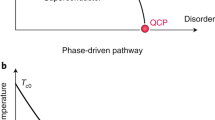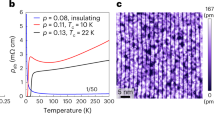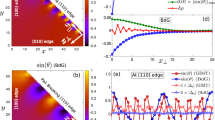Abstract
The most profound effect of disorder on electronic systems is the localization of the electrons transforming an otherwise metallic system into an insulator. If the metal is also a superconductor then, at low temperatures, disorder can induce a pronounced transition from a superconducting into an insulating state. An outstanding question is whether the route to insulating behaviour proceeds through the direct localization of Cooper pairs or, alternatively, by a two-step process in which the Cooper pairing is first destroyed followed by the standard localization of single electrons. Here we address this question by studying the local superconducting gap of a highly disordered amorphous superconductor by means of scanning tunnelling spectroscopy. Our measurements reveal that, in the vicinity of the superconductor–insulator transition, the coherence peaks in the one-particle density of states disappear whereas the superconducting gap remains intact, indicating the presence of localized Cooper pairs. Our results provide the first direct evidence that the superconductor–insulator transition in some homogeneously disordered materials is driven by Cooper-pair localization.
This is a preview of subscription content, access via your institution
Access options
Subscribe to this journal
Receive 12 print issues and online access
$209.00 per year
only $17.42 per issue
Buy this article
- Purchase on Springer Link
- Instant access to full article PDF
Prices may be subject to local taxes which are calculated during checkout




Similar content being viewed by others
References
Goldman, A. M. & Markovic, N. Superconductor–insulator transitions in the two-dimensional limit. Phys. Today 51, 39–44 (November, 1998).
Bezryadin, A., Lau, C. N. & Tinkham, M. Quantum suppression of superconductivity in ultrathin nanowires. Nature 404, 971–974 (2000).
Steiner, M. A., Boebinger, G. & Kapitulnik, A. Possible field-tuned superconductor–insulator transition in high-Tc superconductors: Implications for pairing at high magnetic fields. Phys. Rev. Lett. 94, 107008 (2005).
Sanchez-Palencia, L. & Lewenstein, M. Disordered quantum gases under control. Nature Phys. 6, 87–95 (2010).
Basko, D. M., Aleiner, I. L. & Altshuler, B. L. Metal–insulator transition in a weakly interacting many-electron system with localized single-particle states. Ann. Phys. 321, 1126–1205 (2006).
Oganesyan, V. & Huse, D. A. Localization of interacting fermions at high temperature. Phys. Rev. B 75, 155111 (2007).
Gornyi, I. V., Mirlin, A. D. & Polyakov, D. G. Interacting electrons in disordered wires: Anderson localization and low-T transport. Phys. Rev. Lett. 95, 206603 (2005).
Anderson, P. W. Theory of dirty superconductors. J. Phys. Chem. Solids 11, 26–30 (1959).
Abrikosov, A. A. & Gorkov, L. P. On the theory of superconducting alloys.1. The electrodynamics of alloys at absolute zero. Sov. Phys. JETP 8, 1090–1098 (1959).
Bardeen, J., Cooper, L. N. & Schrieffer, J. R. Theory of superconductivity. Phys. Rev. 108, 1175–1204 (1957).
Bulaevskii, L. N. & Sadovskii, M. V. Localization and superconductivity. Pis’ma Eksp. Teor. Fiz. Zh. 39, 524–527 (1984); JETP Lett. 39, 640–643 (1984).
Sadovskii, M. V. Superconductivity and localization. Phys. Rep. 282, 226–348 (1997).
Kapitulnik, A. & Kotliar, G. Anderson localization and the theory of dirty superconductors. Phys. Rev. Lett. 54, 473–476 (1985).
Ma, M. & Lee, P. A. Localized superconductors. Phys. Rev. B 32, 5658–5667 (1985).
Kotliar, G. & Kapitulnik, A. Anderson localization and the theory of dirty superconductors. II. Phys. Rev. B 33, 3146–3157 (1986).
Feigel’man, M. V., Ioffe, L. B., Kravtsov, V. E. & Yuzbashyan, E. A. Eigenfunction fractality and pseudogap state near the superconductor–insulator transition. Phys. Rev. Lett. 98, 027001 (2007).
Ghosal, A., Randeria, M. & Trivedi, N. Role of spatial amplitude fluctuations in highly disordered s-wave superconductors. Phys. Rev. Lett. 81, 3940–3943 (1998).
Ghosal, A., Randeria, M. & Trivedi, N. Inhomogeneous pairing in highly disordered s-wave superconductors. Phys. Rev. B 65, 014501 (2001).
Finkel’stein, A. M. Superconducting transition temperature in amorphous films. Zh. Eksp. Teor. Fiz. Pis’ma Red. 45, 37–40 (1987); JETP Lett. 45, 46–49 (1987).
Haviland, D. B., Liu, Y. & Goldman, A. M. Onset of superconductivity in the two-dimensional limit. Phys. Rev. Lett. 62, 2180–2183 (1989).
Hebard, A. F. & Paalanen, M. A. Magnetic-field-tuned superconductor–insulator transition in two-dimensional films. Phys. Rev. Lett. 65, 927–930 (1990).
Shahar, D. & Ovadyahu, Z. Superconductivity near the mobility edge. Phys. Rev. B 46, 10917–10922 (1992).
Gantmakher, V. F., Golubkov, M. V., Dolgopolov, V. T., Tsydynzhapov, G. E. & Shahskin, A. A. Destruction of localized electron pairs above the magnetic-field-driven superconductor–insulator transition in amorphous In–O films. JETP Lett. 68, 363–369 (1998).
Steiner, M. & Kapitulnik, A. Superconductivity in the insulating phase above the field-tuned superconductor–insulator transition in disordered indium oxide films. Physica C 422, 16–26 (2005).
Crane, R. et al. Survival of superconducting correlations across the two-dimensional superconductor–insulator transition: A finite-frequency study. Phys. Rev. B 75, 184530 (2007).
Hadacek, N., Sanquer, M. & Villégier, J-C. Double reentrant superconductor–insulator transition in thin TiN films. Phys. Rev. B 69, 024505 (2004).
Baturina, T. I., Mironov, A. Y., Vinokur, V. M., Baklanov, M. R. & Strunk, C. Localized superconductivity in the quantum-critical region of the disorder-driven superconductor–insulator transition in TiN thin films. Phys. Rev. Lett. 99, 257003 (2007).
Dubi, Y., Meir, Y. & Avishai, Y. Nature of the superconductor–insulator transition in disordered superconductors. Nature 449, 876–880 (2007).
Fisher, M. P. A. Quantum phase transitions in disordered two-dimensional superconductors. Phys. Rev. Lett. 65, 923–926 (1990).
Feigel’man, M. V., Ioffe, L. B., Kravtsov, V. E. & Cuevas, E. Fractal superconductivity near localization threshold. Ann. Phys. 325, 1390–1478 (2010).
Sambandamurthy, G., Engel, L. W., Johansson, A. & Shahar, D. Superconductivity-related insulating behavior. Phys. Rev. Lett. 92, 107005 (2004).
Baturina, T. I., Strunk, C., Baklanov, M. R. & Satta, A. Quantum metallicity on the high-field side of the superconductor–insulator transition. Phys. Rev. Lett. 98, 127003 (2007).
Stewart, M. D. Jr, Yin, A., Xu, J. M. & Valles, J. M. Jr Superconducting pair correlations in an amorphous insulating nanohoneycomb film. Science 318, 1273–1275 (2007).
Nguyen, H. Q. et al. Observation of giant positive magnetoresistance in a Cooper pair insulator. Phys. Rev. Lett. 103, 157001 (2009).
Sacépé, B. et al. Disorder-induced inhomogeneities of the superconducting state close to the superconductor–insulator transition. Phys. Rev. Lett. 101, 157006 (2008).
Giaever, I. Energy gap in superconductors measured by electron tunneling. Phys. Rev. Lett. 5, 147–148 (1960).
Fischer, Ø., Kugler, M., Maggio-Aprile, I., Berthod, C. & Renner, C. Scanning tunneling spectroscopy of high-temperature superconductors. Rev. Mod. Phys. 79, 353–419 (2007).
Timusk, T. & Statt, B. The pseudogap in high-temperature superconductors: An experimental survey. Rep. Prog. Phys. 62, 61–122 (1999).
Sacépé, B. et al. Fluctuation-induced pseudogap in thin conventional superconducting films. Preprint at http://arxiv.org/abs/0906.1193.
Ioffe, L. B. & Mézard, M. Disorder-driven quantum phase transitions in superconductors and magnets. Phys. Rev. Lett. 105, 037001 (2010).
Feigelman, M. V., Ioffe, L. B. & Mézard, M. Superconductor–insulator transition and energy localization. Phys. Rev. B 82, 184534 (2010).
Efetov, K. B. Phase-transition in granulated superconductors. Zh. Eksp. Teor. Fiz. 78, 2017–2032 (1980); Sov. Phys. JETP 51, 1015–1022 (1980).
Le Sueur, H. & Joyez, P. Room-temperature tunnel current amplifier and experimental setup for high resolution electronic spectroscopy in millikelvin scanning tunneling microscope experiments. Rev. Sci. Instrum. 77, 123701 (2006).
Acknowledgements
We thank A. Finkel’stein, V. Kravtsov, M. Mézard, Z. Ovadyahu and N. Trivedi for valuable discussions. D.S. and M.O. acknowledge the Israeli Science Foundation and the Minerva Fund.
Author information
Authors and Affiliations
Contributions
B.S., T.D. and C.C. carried out the experiments. B.S., T.D., C.C. and D.S. analysed the data. M.O. and B.S. prepared the InO film samples. B.S., T.D., C.C., D.S., M.F. and L.I. wrote the paper. M.F. and L.I. carried out the theoretical analysis and the numerical simulations. M.S., C.C. and D.S. initiated this work. All of the authors discussed the results and commented on the manuscript.
Corresponding author
Ethics declarations
Competing interests
The authors declare no competing financial interests.
Supplementary information
Supplementary Information
Supplementary Information (PDF 793 kb)
Rights and permissions
About this article
Cite this article
Sacépé, B., Dubouchet, T., Chapelier, C. et al. Localization of preformed Cooper pairs in disordered superconductors. Nature Phys 7, 239–244 (2011). https://doi.org/10.1038/nphys1892
Received:
Accepted:
Published:
Issue Date:
DOI: https://doi.org/10.1038/nphys1892
This article is cited by
-
Topological nodal line in superfluid 3He and the Anderson theorem
Nature Communications (2023)
-
Interdependent superconducting networks
Nature Physics (2023)
-
Suppression of the transition to superconductivity in crystal/glass high-entropy alloy nanocomposites
Communications Physics (2022)
-
Engineered disorder in CO2 photocatalysis
Nature Communications (2022)
-
State with spontaneously broken time-reversal symmetry above the superconducting phase transition
Nature Physics (2021)



